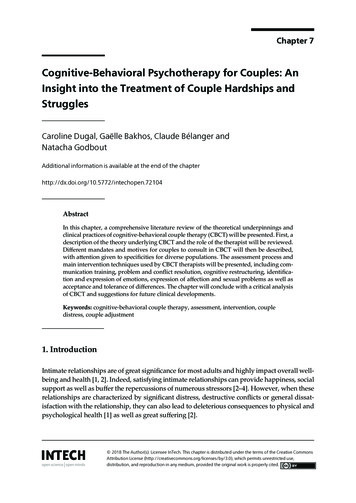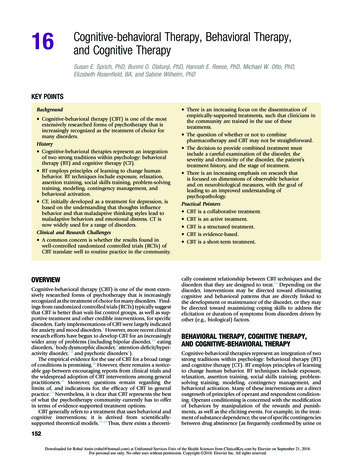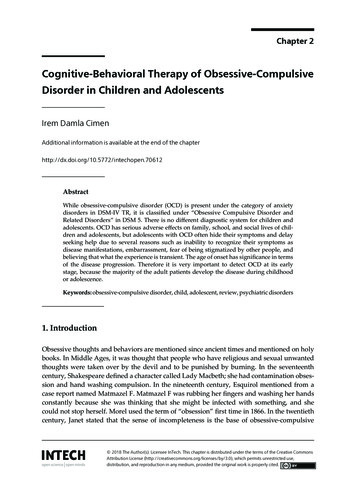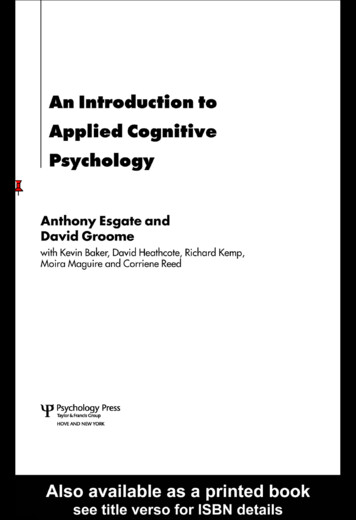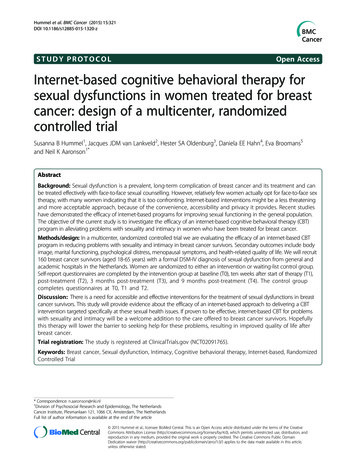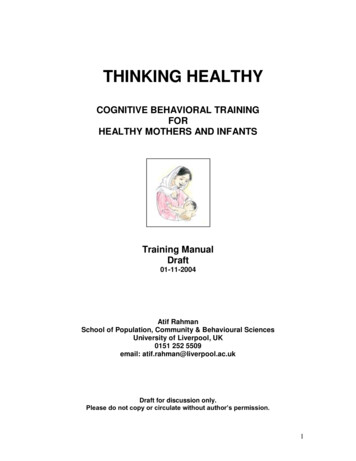
Transcription
THINKING HEALTHYCOGNITIVE BEHAVIORAL TRAININGFORHEALTHY MOTHERS AND INFANTSTraining ManualDraft01-11-2004Atif RahmanSchool of Population, Community & Behavioural SciencesUniversity of Liverpool, UK0151 252 5509email: atif.rahman@liverpool.ac.ukDraft for discussion only.Please do not copy or circulate without author’s permission.1
TABLE OF CONTENTSINTRODUCTION2TRAINING MODULE 1: PREPARING FOR THE BABYSession 1: What is THINKING HEALTHY?11Session 2: Mother‘s personal health21Session 3: Mother‘s relationship with the baby29Session 4: Mother‘s relationship with people around her35TRAINING MODULE 2: THE BABY’S ARRIVALSession 5: Mother‘s personal health42Session 6: Mother‘s relationship with the baby49Session 7: Mother‘s relationship with people around her56TRAINING MODULE 3: EARLY INFANCYSession 8: Mother‘s personal health63Session 9: Mother‘s relationship with the baby70Session 10: Mother‘s relationship with people around her77TRAINING MODULE 4: MIDDLE INFANCYSession 11: Mother‘s personal health84Session 12: Mother‘s relationship with the baby90Session 13: Mother‘s relationship with people around her96TRAINING MODULE 5: LATE INFANCYSession 14: Mother‘s personal health102Session 15: Mother‘s relationship with the baby108Session 16: Mother‘s relationship with people around her1142
INTRODUCTION1.1 Need for an early mother and child health interventionPakistan has a high rate of infant mortality and morbidity - even higher than manyAfrican countries where health conditions are worse and food shortages arecommon. Diarrhoea and malnutrition account for most infant deaths and illness.These conditions are easily prevented. Furthermore, in the first year of life thebrain develops at a very fast rate. Proper attention to the baby during this periodmeans that he or she will grow up to be a much more intelligent child and adult.The first year of a child‘s life is therefore very important for his or her physical aswell as mental development.The mother is the most important person in a baby‘s first year of life. Sheprovides the baby with nutrition, stimulation and protection. It is important for themother to be strong, both physically and mentally, to take best care of the baby.Equally important is the support of people around the mother and baby, such asthe father and grandparents.Research has shown that stresses of everyday life, especially around pregnancyand birth, can affect the thinking style and attitudes of many mothers, so thatcoping with the many tasks of child-care seem difficult. It is here that anintervention can make a great difference, because research has shown that withsome help and support most mothers can change these unhelpful patterns ofthinking and behaving into very effective ones for optimal development of thebaby.1.2 What type of intervention is suitable for mothers and infants in ruralPakistan?Our experience shows that to be successful, such an intervention must have thefollowing ingredients: Psychosocial model: Research shows that unhelpful or unhealthy thinkingstyles can be changed. However, this cannot be accomplished by usingmedicines. A different approach is required, one that relies on talking tothe mother rather than giving her medicines or pills. It is therefore crucialthat both the health worker and the family move away from ―medicalmodel‖ of care. Community-based: For the same reason it is important to ‗treat‘ themother in the community or at home rather than at the health center. LadyHealth Workers routinely see mothers at home during pregnancy and afterchildbirth. They are therefore the most suitable people to deliver this typeof intervention. However, they need training in special techniques to bringabout change in thinking.3
Integrated: LHWs already have a heavy workload. This intervention musttherefore be integrated into existing LHW training so that rather than beingan extra burden, it facilitates their work. LHWs main job is to educate andmotivate their clients and they would gain from training in specialtechniques that facilitate this process. Active and empowering: To be of any use, changes in thinking andattitude have to be accompanied by changes in behaviour and action.Mothers must therefore not become passive recipients of advice butactively participate in seeking and practicing health-promoting activities. Participatory: The intervention should not just be focused on the mother,but include all family members. Health promoting activities involve thewhole household and cannot be practiced in isolation. Simple and Practical: The intervention should be well structured and easyto follow, even by non-literate clients. It should produce tangible results,which clients can monitor easily.1.3 Cognitive Behavior Therapy (CBT) as basis for intervention1.3.1 What is Cognitive Behaviour Therapy―Cognitions‖ refers to our thoughts and ―Behaviour‖ refers to our actions.Cognitive Behavior Therapy (CBT) is an evidence-based and structured form oftalking therapy that aims to alter the cycle of unhelpful or unhealthy thinking(cognitions) and the resulting undesirable actions (behavior).Unhealthy thinking(cognitions)Unhealthy actions(behavior)Fig 1: The cycle of unhealthy cognitions leading to undesirable behaviour4
Research has shown that CBT is very effective in breaking this cycle in peoplewith a number of problems such as depression, poor confidence, lack ofassertiveness, inadequate coping skills, passivity and difficulty with relationships.Our research has shown that many mothers whose infants have poor healthsuffer from such problems. Thus, both mothers and their infants can gain fromthis type of therapy.The cycle is broken in two ways: Altering ways of thinking — a mother's thoughts, beliefs, ideas, attitudes,assumptions, mental imagery, and ways of directing her attention — forthe better. This is the cognitive aspect of CBT. Helping the mother meet the challenges and opportunities of raising herbaby with a clear and calm mind — and then taking actions that are likelyto have desirable results. This is the behavioral aspect of CBT.CBT provides clear structure and focus to dealing with health and psychosocialproblems. Clients take on valuable ―homework‖ projects to speed up theirprogress. These assignments — which are developed as much as possible withthe clients‘ active participation — extend and multiply the results of the workdone during a session.One of the most powerful techniques in CBT to change unhealthy thinking stylesis imagery. The client is encouraged to recall an image from real life that containsunhealthy cognitions and consequent undesirable behaviour. She is thenencouraged to modify the image by thinking in a healthier manner. Thus use ofimages and imagination can be employed in people whose strength is not verballanguage.1.3.2 Adapting the CBT approach to mother and infant health in the antenataland postnatal periodIt can be seen that the CBT approach fulfils many of the requirements outlined insection 1.2. The approach can be used with mothers, infants and their families inPakistan with the following adaptations: Focus on mother and infant health rather than maternal depression: Manywomen and their families do not see depression as a problem requiringintervention. Some would see it as a stigma. Health is a more universallyunderstood and accepted concept than depression. Optimal developmentof the infant can provide the pivot around which attitudes and thinkingstyles can be changed for the better. Family members may disagree onmany things but infant health is usually a common agenda. Within this5
agenda, efforts to improve the physical and psychological health of theprimary caregiver, the mother, can be addressed without much resistanceor stigma. Modified use of imagery: Using carefully researched and culturallyappropriate illustrations, the intervention could use imagery techniques togood effect, especially in low-literacy populations. These illustrations couldhelp mothers form their own mental images, which would then be modifiedby training. These illustrations could also serve as visual cues in betweensessions. Training rather than therapy: In many ways CBT resembles education,coaching or tutoring. We have therefore called the intervention CognitiveBehavior ―Training‖ rather than ―Therapy‖, and the therapist ―trainer‖ ratherthan ―health worker‖. This emphasizes the active and non-medicine aspectof the intervention. Under the trainer‘s guidance, CBT ―trainees‖, i.e.,mothers, will share in setting health-benefiting goals. Family oriented: While the mother is the focus of the training, the wholefamily is actively involved. This is important to make effective use of familymembers for support and assistance of mother and infant. It also removesthe possible ‗paranoia‘ of family members against unpopular programmes,e.g., ―this is a covert birth control programme‖. Developmentally appropriate: The contents of the training sessions andactivities for the mother are tailored according to the age anddevelopmental level of the infant and the needs of the mother at eachstage. Culturally adapted: Sessions and homework activities should be culturallyappropriate. This can be achieved through careful field-testing of theintervention during the development phase. For example during the chilla(40-day confinement of mothers after delivery), women do not go out. Itwould not be appropriate to suggest outdoor activities during this period.1.4 THINKING HEALTHY: Cognitive Behaviour Training for Mothers andInfantsThe THINKING HEALTHY training programme is a CBT based interventiondeveloped especially for developing countries like Pakistan. The interventiontargets mothers who have many psychosocial stresses and may be depressed.However it can be used as a motivation tool for all mothers living insocioeconomically deprived areas with low literacy rates. It focuses on the healthof both mother and baby and encourages participation of the whole family. Theapproach used is simple and pictorial but retains the essential characteristics of6
CBT. It has five modules covering the period from third pregnancy trimester tofirst year of infant‘s life. The structure of the THINKING HEALTHY programme isshown in table 1 and the core features are described below.ModulesSessionsFrequencyApproximate periodModule 1Preparing for thebabyModule 2The baby‘s arrivalSessions 1-4Weekly30th to 33rd gestationalweekSessions 5-7Fortnightly3rd to 5th week postnatalModule 3Early infancySessions 8-10Monthly2nd to 4th month postnatalModule 4Middle infancySessions 11-13Monthly5th to 7th month postnatalModule 5Late infancySessions 14-16Monthly8th to 10th month postnatalTable 1: Structure of the THINKING HEALTHY CBT programme1.4.1 Three areas of THINKING HEALTHYEach module focuses on three areas relevant to mother and infant health duringpregnancy and after childbirth – the mother‘s personal health, the mother-infantrelationship, and the psychosocial support of significant others. Mother’s personal health: Mothers who are depressed or under stressoften ignore their personal health, e.g., their diet and rest. Often, they donot have the energy or motivation to seek appropriate health care forthemselves or their children. They get caught up in a cycle of inactivity,which further damages their health and worsens the depression. This alsoincreases the risk for low birth weight and other health problems in theinfant. Each module contains a session addressing the mother‘s personalhealth. Mother-infant relationship: Mother-infant relationship includesresponding appropriately to the infant‘s emotional needs, frequent physicalinteraction, establishing eye contact, verbal communication, and creatinga stimulating physical environment for the child through toys, pictures and7
books. Similarly, feeding behaviours (both breast and bottle), such asappropriate nipple insertion and removal, positive affect during feeding,and provision of nourishing foods (as opposed to comforting foods such assweets) are also aspects of this interaction and make importantcontributions to the growth of the infant and young child. The quality of thisreciprocal relationship is important for optimal health of both mother andinfant. Each module contains a session to address mother-infantrelationship. Relationship with people around the mother and infant: Researchshows that the social network or support system available to the mother isimportant in determining the quality of care she is able to provide to herinfant. Social support can be divided into intimate versus community andstructural versus functional. Intimate support comes from members of theimmediate household (husband, in-laws) while community support maycome from the neighborhood or community associations. Social structuressuch as marriage, religious institutions, and the health center arestructures of support. Stressed or depressed mothers often find it difficultto engage and maintain social networks. Each module contains a sessionto address the social support of mother and infant.1.4.2 Three steps to THINKING HEALTHYEach session employs the three-step approach that is repeated throughout theprogramme. Step-1 - Learning to identify unhealthy thinking: In order to promotehealthy thinking, it is important to be aware of the common types ofunhealthy or unhelpful thinking styles that gradually develop as a result oflife problems or experiences. Mothers are educated about such unhealthythinking styles and learn to identify them.Step-2 - Learning to replace unhealthy thinking with healthy thinking:Identifying such unhealthy thinking styles enables mothers to examinehow they feel and what actions they take when they think in this way. Theprogramme helps mothers question the accuracy of such thoughts andsuggest alternative thoughts that are healthier. We have modified thetraditional CBT approach by involving the whole family in suggestingalternative healthy thinking. Thus they can assist the mother challengeand replace unhealthy thinking with healthy thinking.Step-3 - Practicing healthy thinking and acting: The programme suggestsactivities and homework to help mothers to practice thinking and actinghealthy. Carrying out these activities is essential for the success of theprogramme. Mothers receive health education and other materials tailoredto their individual needs to help them progress between sessions. Thefocal point of these activities is a designated ―health corner‖ in each8
house, and the ―Mother and Child Health Calendar‖ that is provided toeach trainee.1.4.3 Training Instruments Trainer‘s manual: The training manual, of which this is the introductorychapter, gives clear step-by-step instructions to the health worker on howto conduct each session. It explains the theoretical rationale of theprogramme, serves as reference manual for the trainers and forms thebasis for their training programme. Activity workbooks: It is important for the training to be structured andstandardised. Each of the 5 modules has a specially designed pictorialactivity workbook that is used by the trainer to conduct a session with themother. Each mother will have her own activity workbook where activitiescarried out in each session will be noted. Calendar: It is essential that the mother monitors herself and carries outthe homework between sessions. The calendar, consisting of pictorial andverbal key messages of each session, serves as a visual cue for thewhole family to follow the programme between sessions. In addition, thecalendar has monitoring tools that help the mother chart her ownprogress, and that of her infant‘s, throughout the programme. Theprogress between sessions is discussed in the next session.1.4.4 Inbuilt monitoring systemIt is important that the sessions are delivered in the same way to all mothers. It isalso important to ensure that both health workers and mothers are adhering tothe given instructions as much as possible. The activity workbooks andmonitoring tools will not only assist the mother in charting her progress, but alsoassist the research team to ensure that the programme is actually beingdelivered appropriately. From time to time, a member of the research team willanalyse these instruments for this purpose.1.4.5 Cross-reference with LHW ManualThe THINKING HEALTHY programme incorporates the health education materialcontained in the LHW‘s Training Manual used by the Department of Health fortheir training. Thus they will be using their existing knowledge, but delivering it inthe THINKING HEALTHY format which is more effective for health education ofthe most deprived or depressed mothers. Where necessary, the THINKINGHEALTHY manual is cross-referenced with the LHW Training Manual so thatboth can be used in conjunction. Many LHWs have told us that the THINKINGHEALTHY approach gives structure to their work and makes it more interestingfor them as well as their clients.9
1.5 Requirements of a good CBT trainerA feature of the THINKING HEALTHY programme is that it does not requirespecialists to carry it out. Anyone with the educational level of a Lady HealthWorker (Middle or Matriculation) can become a trainer after attending a two-daycourse. However, trainers will be more effective if they inculcate the followingattributes in themselves: Psychological mindedness: The ability to listen to and empathize withupset feelings. Being able to shift from the directive medical model to themore ‗client-centered‘ active problem-solving model. Optimism: Some unhelpful thinking patterns and behaviours are verydifficult to shift. The results are not immediate. At times, the trainer may befrustrated if the mothers and families do not cooperate fully withinstructions. Being an optimist will help the trainer to keep on tryingdespite these difficulties. Good motivational skills: For the same reasons, the trainer must be agood motivator. Skills of persuasion are important to create changes inthinking. The programme helps you develop these further. Good public relations skills: To gain the confidence and trust of household,the trainer must develop and employ these skills. Cultural sensitivity: The trainer should develop an understanding of localculture. At times, the trainer has to challenge ideas that are part of theculture. This has to be done sensitively or else there is a risk that thefamilies may no longer want to continue with the programme.1.6 How the THINKING HEALTHY approach was developedThis manual has is based on research we have been conducting in ruralRawalpindi for the last 5 years. This consisted of 3 phases. In the first phase, anepidemiological study was carried out to understand the stresses that mothersliving in poor areas face and the impact of such stresses on the mother andinfant. Over 300 mother-infant pairs were studied from third trimester pregnancyto one year after birth, using various interviews and questionnaires. An importantfinding was that about a quarter of the mothers suffer from depression shortlyduring pregnancy or in the first year after giving birth. The infants of thesemothers have poorer growth and higher rates of diarrhoea compared to nondepressed mothers. We also identified a number of social and ‗life-problems‘such mothers faced.10
In the second phase, smaller groups of depressed and non-depressed motherswere studied through focus-group discussions and in-depth interviewing.Thinking styles of both depressed and non-depressed mothers were studied andthe manner in which they dealt with health problems was explored. The manualincorporates information obtained from these 2 phases of research.In the third phase, the manual was piloted to see if it was easily understood andfound practicable by health workers and mothers in rural Rawalpindi. Manyimprovements in language and presentation were carried out, before reaching itspresent form.However, we would like to continue to improve this manual. Therefore commentsand suggestions are welcome. Please give these to your trainer or post them tothe address below.Atif RahmanH.No1, Street 64F-7/3, IslamabadPakistan11
Training Module 1: PREPARING FOR THE BABYSession 1 - What is THINKING HEALTHY?Learning Objectives of this session:The purpose of this session is to engage the mother and family in thisprogramme. The THINKING HEALTHY approach and its components will beexplained. Ground rules will be established for future sessions. The requiredactivities for the session will be carried out and homework given.Instruments required:A) Activity Workbook 1: Preparing for the babyB) Health Monitoring CalendarThe first introduction: This is important. Start by saying that the progress of anysociety depends upon the good health of its future generation. If our children arehealthy and bright, they can deal with challenges of life and become assets forthe family and community. When they go to school, they will be able to learnmore effectively. If they become farmers, they can be more productive. For ahealthy future, the baby needs to be looked after very carefully when it is in themother‘s womb and in the first year of life. That is when the foundations for thefuture are being laid. As the mother is so important to the infant during thisperiod, her physical and mental health will determine how the baby will progress.Support of the whole family is important.Do not be condescending. Say that the family probably knows many good waysof bringing up children, but you would like to SHARE (not dictate) some newconcepts.Now open page 1 of Activity Workbook 1:1. Two sides of a picture:AB12
1.1 Objective: To engage the family in the training programme.1.2 Instructions: Show the mother (and other family members) the two pictures for about half aminute. Ask the mother which picture she would prefer herself to be in. Almost allmothers would prefer picture B. Ask her to give the reasons for liking picture B. Note down these reasons onthe activity workbook in the space provided. Now ask her about picture A. What types of problems are there likely to be inthe family shown? If necessary prompt: illiteracy, poverty, personal health, andfamily conflicts.1.3 Dos and don‘ts: Don‘t blame the characters in picture A of being weak or bad. Say thatstresses of life can sometimes make anyone of us give up hope and stop trying. Do let mother and family talk about their own problems. Listensympathetically.2. Balancing life problemsAB2.1 Objective: To shift the agenda of the family from problems to finding solutions.2.2 Instructions: Picture A shows a dejected mother weighed down by life problems. Askmother if this is how she sometimes feels. Now show her picture B. Ask her to note that the problems have not goneaway. But the woman in the picture is up on her feet trying to balance life‘sproblems. Explain that this programme has been designed to help mothers try toachieve this. Explain that this programme cannot make life problems disappear. It does notoffer monetary support or medical care other than advice. However it can helpmothers and families help themselves to achieve better health for mother andbaby. Life problems will not go away but may seem more manageable after awhile.13
Do give the mother time to look at the images. Don‘t be too directive. Give family members the opportunity to voice theiropinions. Do not challenge at this stage. Listen sympathetically. Now ask if they would like to know more about the THINKING HEALTHYprogramme.3. The 3 Areas of THINKING HEALTHYA3.1 Objective: To introduce the 3 areas that form the basis of the programme andwill be the focus of future sessions.3.2 Instructions: Explain that you will meet mother, baby and family 15 times in the next year. Show Picture A to mother. Ask her to focus on top middle bubble. Explain thatmothers who are under stress often ignore their personal health, e.g., their dietand rest. Often, they do not have the energy or motivation to seek appropriatehealth care for themselves or their children. They get caught up in a cycle ofinactivity, which further damages their health and worsens their situation. Poorpersonal health increases the risk for low birth weight and other health problemsin the infant. Therefore 5 out of 15 meetings will focus on mother‘s personalphysical and psychological health. Now ask her to focus on top left bubble. Explain that the quality of relationshipbetween mother and baby is important for optimal health of both mother andinfant. Aspects of this relationship include not just appropriate feeding butresponse to the infant‘s emotional needs, frequent physical interaction andcreating stimulating physical environment for the child. These activities makeimportant contributions to the growth and well being of the infant and young child.Five out of 15 sessions will address mother-infant relationship. Now ask her to focus on top right bubble. Explain that the social network orsupport system available to the mother is important in determining the quality of14
care she is able to provide to her infant. Stressed or depressed mothers oftenfind it difficult to engage and maintain social networks. By losing out on thissupport, both mother and baby are at increased risk of stress and poor health.Therefore 5 out of 15 sessions will help the mother and family optimize theavailable support. Focusing on bottom middle bubble, say that research has shown these 3areas to be important for mother and baby‘s health. Ask mother and family fortheir views and if they feel these areas are important. Ask if family would like to know how this programme can help.4. The 3 steps to THINKING HEALTHY4.1 Objective: To introduce the basic principles of Cognitive Behaviour Trainingthat will be used in each session.4.2 Instructions: Explain that every action starts as a thought in our mind. The thought usuallydetermines our feelings, actions and behaviour. The behaviour then hasconsequences. Explain that stresses of everyday life, especially around pregnancy and birth,can affect the thinking patterns of many mothers, so that coping with lifeproblems may seem difficult. These ―negative‖ thinking patterns especially affectthe 3 areas discussed, viz., personal health, mother-baby interaction, andrelationship with others. When it becomes difficult to change these patterns ofthinking and the resulting feelings and behaviour starts to have negative effectson these three areas, help may be required. This programme can help mothers try to change these negative patterns ofthinking and behaving into positive ones so that coping with life tasks, especiallythose of bringing up the baby, becomes easier. This is done in 3 steps:AStep 1: Learning to identify negative thoughts: Ask mother to focus on picture A,the symbol for this step. Explain that in order to promote healthy thinking, it isimportant to be aware of the common types of negative or unhealthy thinkingstyles. By conducting research on many thousand ordinary people like us,scientists have defined the following types of negative or unhealthy thinkingstyles. Make the mother familiar with the symbol below for learning to identifynegative thoughts and go through the following examples in Box 1. Tell mother15
that we will talk a bit more about such thoughts and their effects later in thesession.Unhealthy thinking styleTypical thoughtsBlaming oneselfIf things go wrong, it is always yourfaultIf my child falls ill, it isalways my fault, I am not agood motherNot giving oneself creditIf things go well, its luck orsomebody else‘s doingIts only luck that mychildren are healthyGloomy view of futureBelieving or predicting that badthings are going to happenNothing can stop mychildren from gettingdiarrhea this summerMind readingNegative view of how others seeyouI often think that othersthink badly of meThinking in extremesIf things can‘t be perfect there‘s nopoint tryingAs I am uneducated, I willnever be a capablemotherNot believing in one’s capabilityI can never achieve thistaskGiving up before tryingI am no good at thisSymbolBox 1B Step 2: Learning to replace negative or unhealthy thinking with positive orhealthy thinking: Ask mother to focus on picture B. Explain that identifying theabove unhealthy thinking styles enables us to examine how we feel and whatactions we take when we think in this way. The programme will help the motherquestion the accuracy of such thoughts and suggest alternative thoughts that are16
healthier. With practice the mother can learn to challenge and replace unhealthythinking with healthy thinking. Make the mother familiar with the symbol forlearning to replace negative or unhealthy thinking with positive or healthythinking.C Step 3: Practice healthy thinking and acting: Ask mother to focus on pictureC. Explain that the programme suggests activities and homework to help mothersto practice thinking and acting healthy. Carrying out these activities is essentialfor the success of the programme. Mothers will receive health education andother materials tailored to their individual needs to help them progress betweensessions. Make the mother familiar with the symbol for learning to practicehealthy thinking and behaviour.The Three Steps to Thinking HealthyDNow show the mother picture D. Summarise the 3 steps and ask if sheunderstands the concept. Explain that the same 3 steps will be used for each ofthe 3 areas throughout the programme.Ask mother and other family members if they have any questions. Then ask ifthey agree to take part in the programme. Read out the ‗informed consent form‘.17
5. Ground rules for taking part in programme:Objective: To explain the rules that need to be observed by mother and family inorder to take part in the programme.Instructions: Go through each of the rules (with accompanying picture) in theactivity book, making sure the mother understands and agrees.Rule 1: Active participation:Explain that the programme does not offer financial support or medical care, buthelps mothers to help them
1.4 THINKING HEALTHY: Cognitive Behaviour Training for Mothers and Infants The THINKING HEALTHY training programme is a CBT based intervention developed especially for developing countries like Pakistan. The intervention targets mothers


